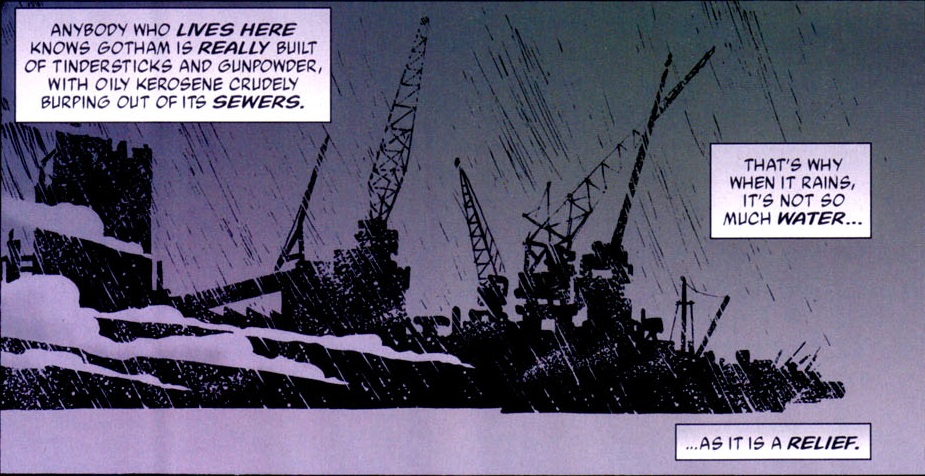 Batman #620
Batman #620
Since 1939, there have been plenty of offbeat Batman writers, but I get a special kick out of the fact that Brian Azzarello has been allowed through the gates. After all, Azzarello seems mostly at home telling viciously violent, R-rated, immoral stories, and when faced with corporate-owned properties he enjoys writing them totally out of character… I’m not complaining though, since we’ve gotten some magnificently outrageous comics out of the deal!
To be sure, Brian Azzarello is clearly a big fan of puns and hardboiled fiction, two longstanding staples of Batman comics. In fact, some of Azzarello’s coolest works involved filtering old hardboiled narratives through different genres (for example, his Cage is a blaxploitation version of Dashiell Hammet’s Red Harvest, and his El Diablo is a western version of the underrated film noir Hollow Triumph). The intricate plotting and manly tone are also typical of classic pulps, although the non-stop parade of slang and sleaze sometimes feels more like the reader is repeatedly being hit on the head with a James Ellroy tome. Most of all, you can tell you’re reading a Brian Azzarello comic by the way in which it is enamored with language: from witty to symbolic to groan-inducing wordplay (‘It’s Renny.’ ‘What, your nose? Well then, here’s a hankie.’), the cascading double meanings bounce around between sophomoric and quasi-Shakespearean.
Brian Azzarello’s eccentric voice has found its match in similarly eccentric artists. Most notably, Eduardo Risso’s distinct visual style is perfect for stories of scruffy male characters and voluptuous femme fatales. Risso’s meandering POV also adequately complements Azzarello’s own meandering narration and dialogue. Taking advantage of this chemistry, the duo produced a number of neat crime comics, such as the clichéd Jonny Double, the epic 100 Bullets, and the futuristic Spaceman.
Risso’s and Azzarello’s first Batman-themed collaboration was the black & white short story ‘Scars.’ It’s basically a conversation between Batman and the serial killer Victor Zsasz in which the Dark Knight argues that real power is looking into the eyes of someone you’ve just saved and knowing that now they owe you. Way to sound heroic, Batman!
They followed this up in 2003 with the story arc ‘Broken City,’ now joined by the rest of the 100 Bullets team, namely colorist Patricia Mulvihill, letterer Clem Robins, and cover artist Dave Johnson. In a way, the whole thing almost feels like a spin-off of that title, complete with a blink-and-you-miss-it cameo by Agent Graves in the second chapter.
Like their magnum opus, ‘Broken City’ has a whirling plot, but in contrast to 100 Bullets it owes more to detective fiction than to gangster sagas. And it somehow manages to be even moodier:

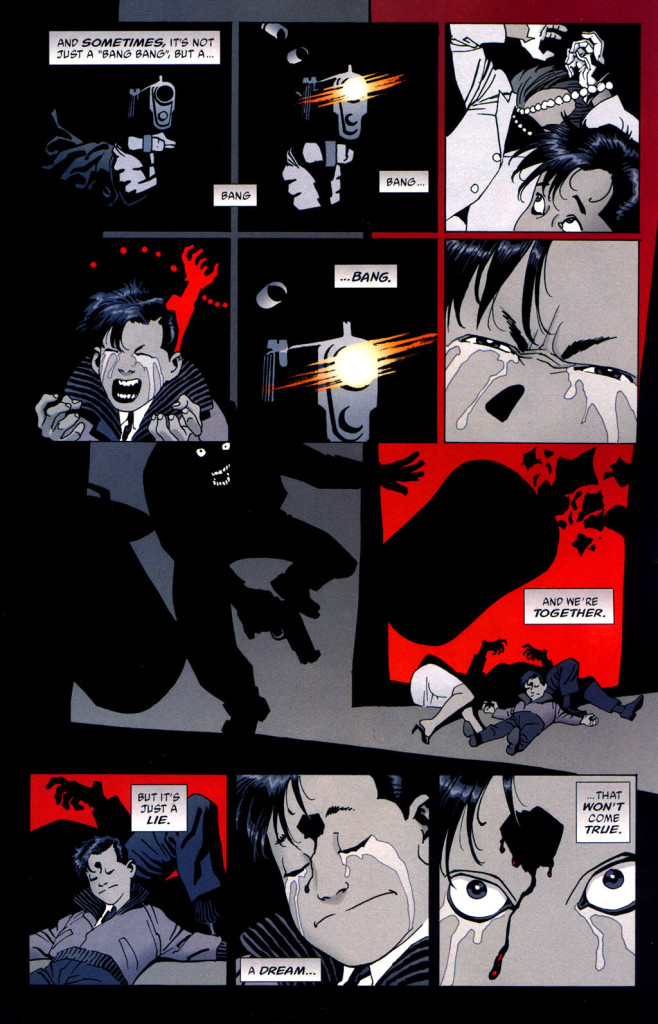 Batman #622
Batman #622
Always one for twisted, broken protagonists, Brian Azzarello tries his best to take Batman into some seriously dark corners. A key plot point in the story revolves around him dealing with the murder of two parents who left a surviving kid behind. We also get a flashback into Bruce Wayne’s final moments with his own parents, which is emotionally powerful but pretty much inconsistent with any other depiction of these events seen before or since!
Me, I love it. ‘Broken City’ has a noir-as-fuck attitude to the point of kitsch. Killer Croc, the Penguin, and Scarface seem like they just walked out of an audition for a public reading of The Black Dahlia. Even the Caped Crusader is in on the joke, getting his fair share of risqué double entendres:
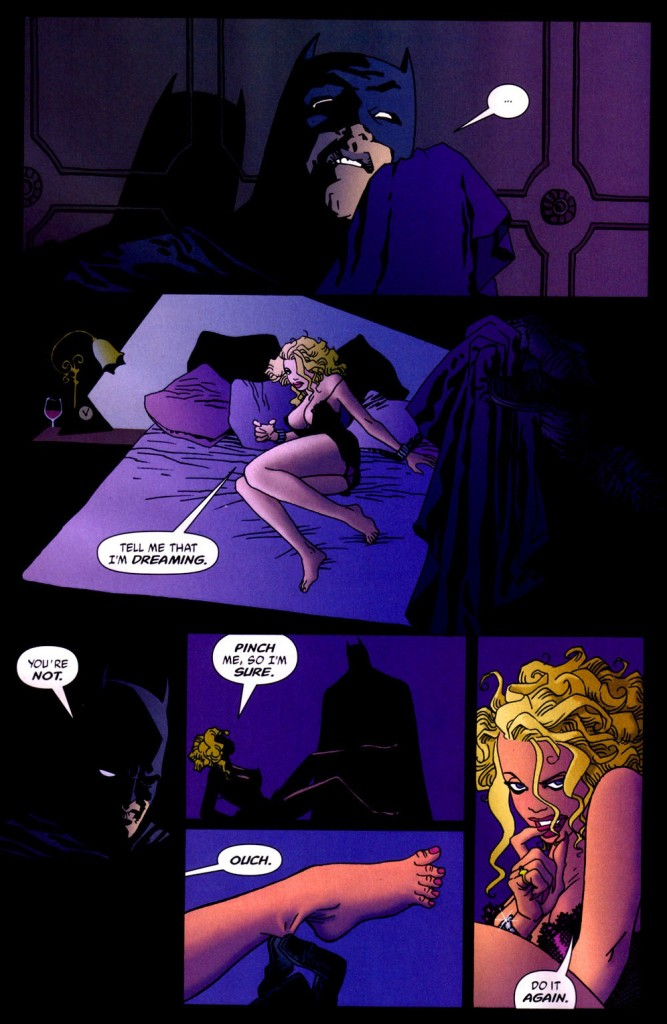
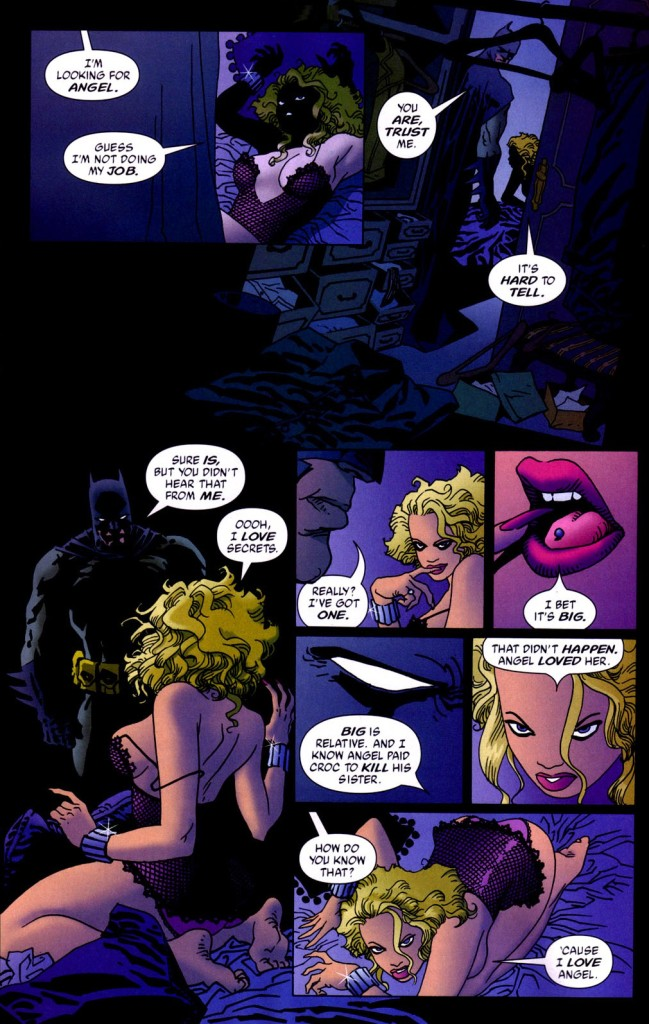 Batman #620
Batman #620
Azzarello, Risso, Mulvihill, and Robins reunited to do a noirish Batman mystery for DC’s experimental Wednesday Comics. Their most acclaimed Batman-related project, however, was ‘Knight of Vengeance,’ a spin-off from DC’s 2011 crossover Flashpoint. Set in a world where Bruce died at the hands of a mugger and it was his surviving father, Thomas Wayne, who became a bat-clad vigilante, ‘Knight of Vengeance’ is a radical reimagining of the Batman mythos. Azzarello took advantage of the freedom granted by this alternative continuity to write a Dark Knight close to his usual sensibilities, i.e. embittered and bloodthirsty, not to mention an adept of ridiculously elaborate turns of phrase.
Much like TV’s True Detective, these works are all surface passing for substance – and what a sexy (and sexist) surface it is! They have a highly recognizable, unifying style, starting with Risso’s pyrotechnic pencils and inks, which even riff on iconic panels from The Killing Joke, The Dark Knight Returns, and Year One, as if to prove that he can outdraw anyone who gets in the way…
Another singular artist who has regularly been paired with Azzarelo is Lee Bermejo. The contrast to Eduardo Risso couldn’t be greater, as Bermejo has quite a photorealistic approach to comics. He gives Gotham City an impressive retro look, rendering it in a way that you can almost feel the textures and smells:
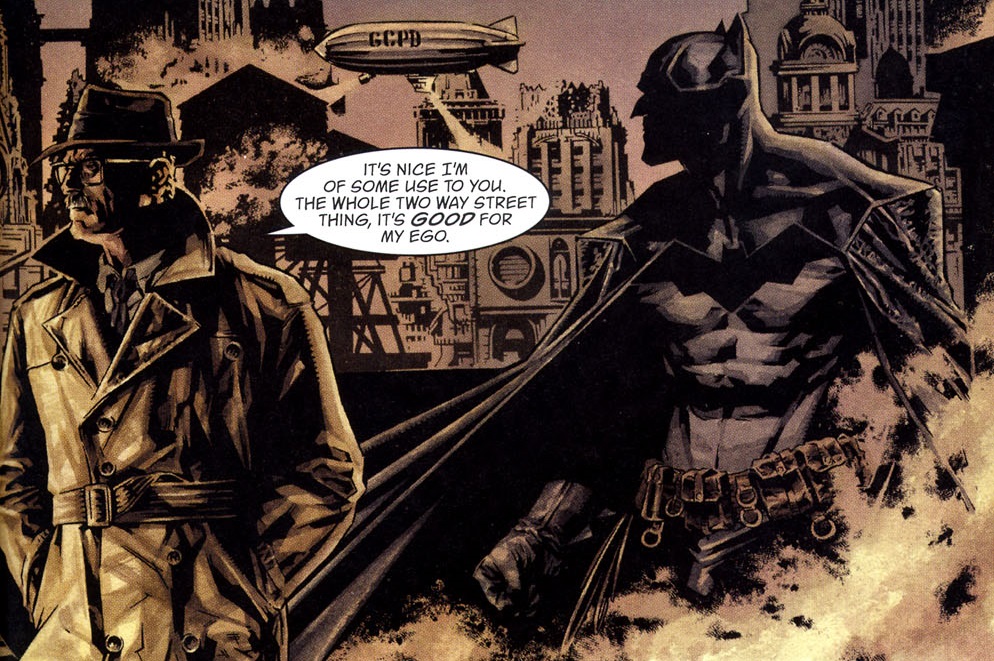 Batman/Deathblow: After the Fire
Batman/Deathblow: After the Fire
Azzarello and Bermejo first worked together on After the Fire, a kind of crossover between Batman and Wildstorm’s black ops super-agent Deathblow. I say ‘kind of’ because this mini-series flies in the face of the conventions for this type of stories by never having the two characters actually meet (much less fight and team up, as the formula goes) – although there is an awesome sequence in which Bruce Wayne totally disguises himself as Deathblow! Unlike Azzarello’s later, wacky Deathblow series, After the Fire is a legitimately taut espionage tale, typically elliptical yet rewarding to readers who pay close attention.
That said, the most accomplished Azzarello-Bermejo collaboration has got to be Lex Luthor: Man of Steel, an excellent mini-series told from the point-of-view of Superman’s classic nemesis (and also a fine companion piece to Rick Veitch’s and Tommy Lee Edwards’ The Question: The Devil’s in the Details, which you should own). In part, the comic works because Brian Azzarello sticks to what he does best, telling convoluted stories about Machiavellian bastards, instead of trying to write a conventional superhero tale (he tried it with Superman: For Tomorrow, with catastrophic results). But more than that, the rapport between writer and artist really gelled in this book, particularly in the way they played with reflecting surfaces, feeding off Azzarello’s flair for juxtaposing multiple layers of meaning on each gesture and exchange:
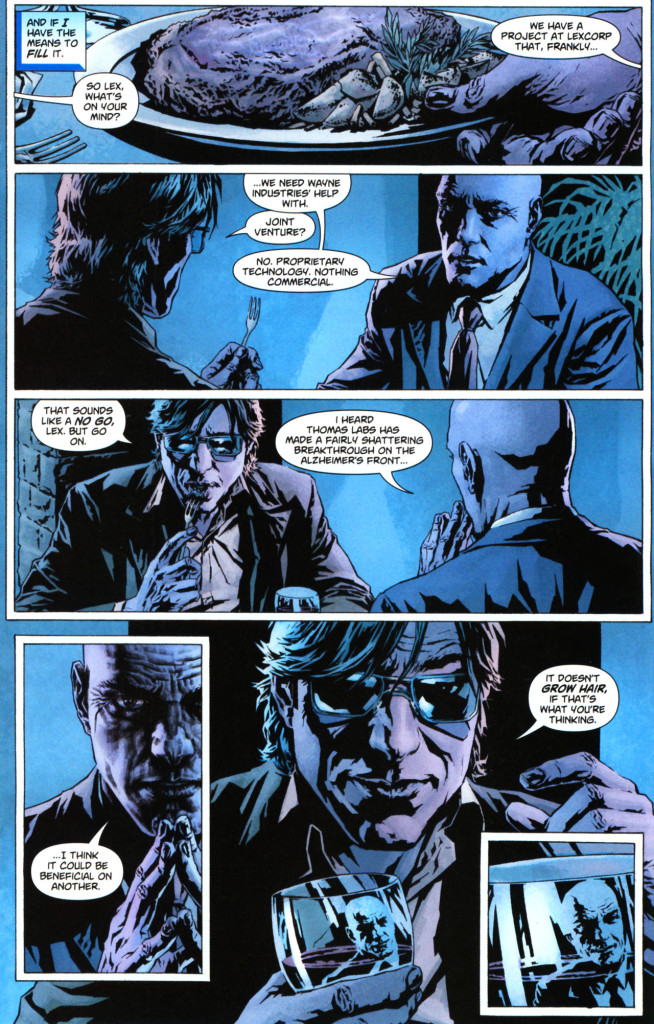
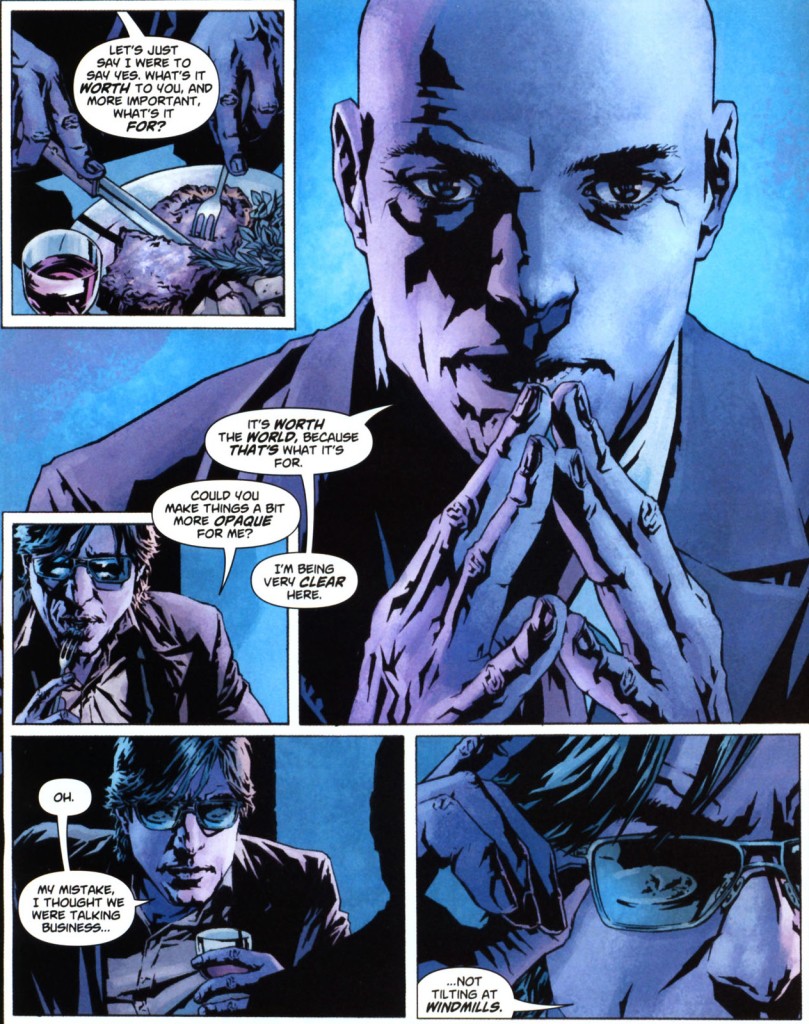 Lex Luthor: Man of Steel #3
Lex Luthor: Man of Steel #3
The team followed Luthor with Joker, a graphic novel spotlighting the Clown Prince of Crime. Bermejo brought his A-game, drastically redesigning much of Batman’s rogues’ gallery and nailing a Joker that wasn’t far away from Heath Ledger’s in The Dark Knight movie (which came out around the same time). On the other hand, Azzarello produced what is probably the most godawful script of his career, basically piling scenes upon scenes of the Joker committing gratuitous, sadistic acts, from skinning a guy alive to raping the wife of his own henchman. Too stomach-churning to be fun, yet too ludicrous to be taken seriously, one of the best-looking Batman books out there also happens to be the most unpleasant to read (fortunately, Bermejo later found a better vehicle for his luscious art in the Dickensian Batman graphic novel Noel).
But hey, at least there is a bit in Joker where the Dark Knight provides a hilariously mean-spirited justification for his costume:
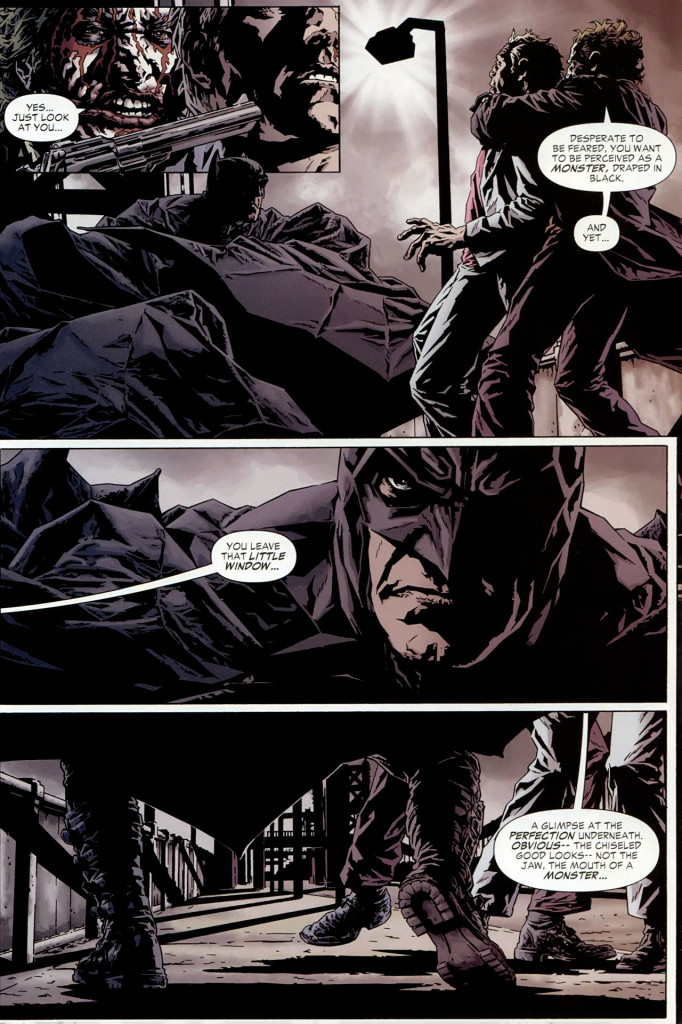
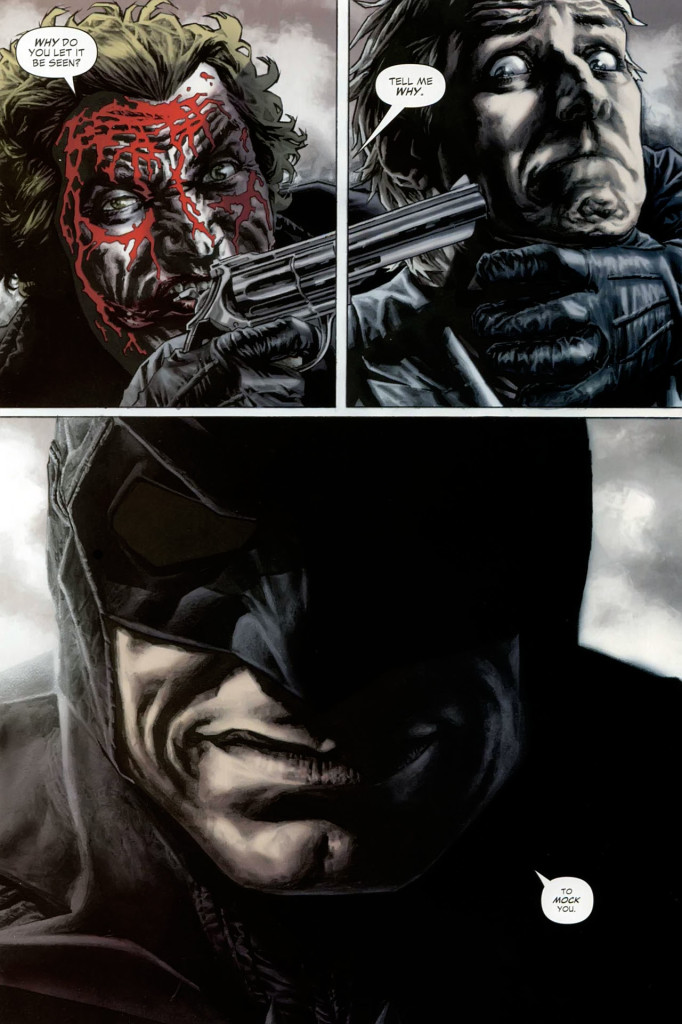 Joker
Joker
Azzarello and Bermejo partially redeemed themselves with a fun spread in Superman/Batman #75, featuring Lex Luthor and the Joker in a Calvin & Hobbes-like comic strip. And who knows, maybe one day we’ll get to see if Azzarello’s, Bermejo’s, and Risso’s Batman: Europa is as mind-blowing as it sounds!
Brian Azzarello has worked with several other artists – in fact, while firmly holding on to his specific voice, the man has gradually shown increasing range and adaptability. Based on his early, chauvinistic crime comics, I could hardly have imagined that Azzarello would end up writing such an exciting, fantasy-heavy run on Wonder Woman!
To be fair, a great example of his versatility came out already in 2004. As a tribute to editor Julie Schwartz, DC published a series of comics inspired by outlandish covers Schwartz had commissioned back in the Silver Age. Azzarello wrote a hysterical story based on a cover with Green Lantern selling power rings, including this insane gem of a page:
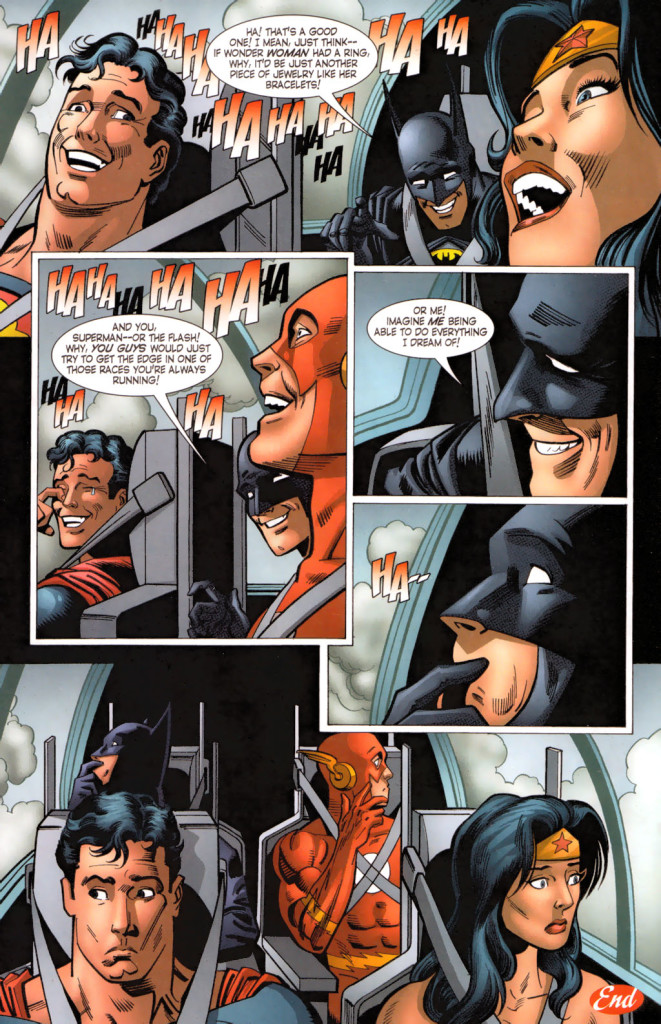 DC Comics Presents Green Lantern
DC Comics Presents Green Lantern
Given the brooding pseudo-gravitas of most of his previous work, it might come as a shock that Brian Azzarello has such a zany sense of humor (a vein he explored further in Doctor 13: Architecture and Mortality). Then again, there are only so many puns you can make before you bow down to Groucho Marx.
Despite his WTF depictions of the Dark Knight, somehow Brian Azzarello became a go-to guy for self-contained Batman stories. He wrote ‘Cornered,’ a short tale about corner kids and urban crime illustrated by Jim Mahfood (Gotham Knights #35). He wrote ‘Poison,’ a lame Poison Ivy piece to showcase Jordi Bernet’s cheesecake art (Solo #6). He even wrote a forgettable sequence for the animated movie Batman: Gotham Knight.
Ultimately, Azzarello seems to have been given carte blanche to piss all over traditional takes on the Caped Crusader:
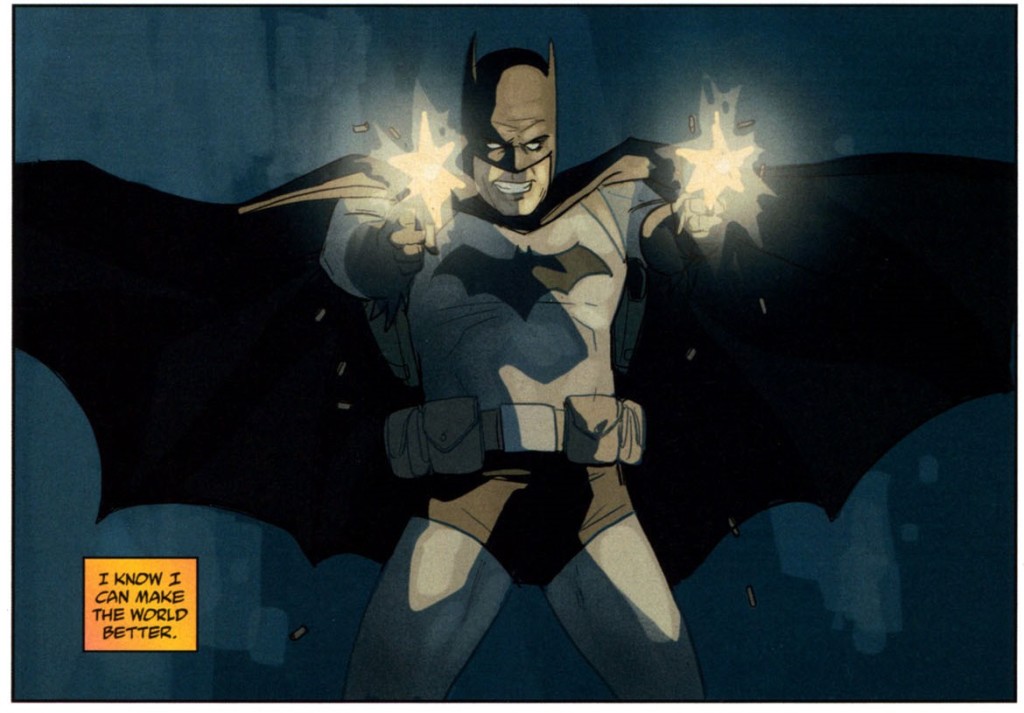 Batman / Doc Savage Special
Batman / Doc Savage Special
He got another opportunity to so with First Wave, a series set in an alternate universe that brought together pulp heroes such as Doc Savage and The Spirit (yes, Will Eisner’s The Spirit). Brian Azzarello threw an alternate Batman into the mix, one closer to The Shadow’s influence in the very early Batman stories – a gun-toting Dark Knight, for Kane’s sake!
Even in his comics set outside the mainstream DC Universe, Azzarello has occasionally found a way to put further iconoclastic twists into Batman’s mythology. In Dark Horse’s anthology Noir: A Collection of Crime Comics, Brian Azzarello contributed with a short story (illustrated by Fábio Moon and Gabriel Bá) which revised a seminal detail in Batman’s origin. And then, of course, there is the final arc of Azzarello’s Hellblazer run…
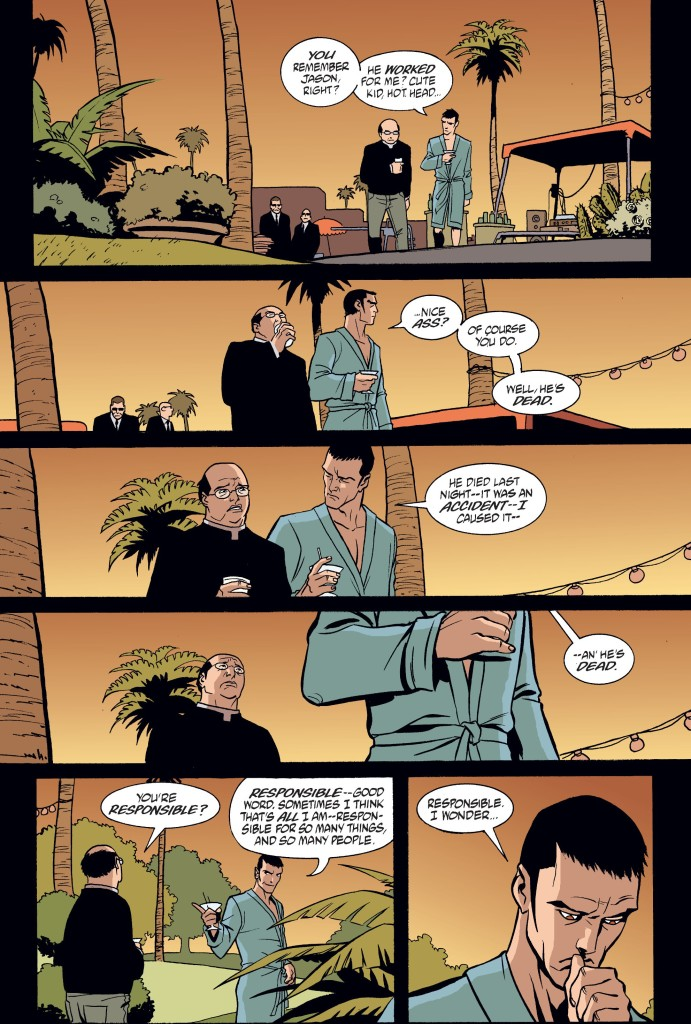
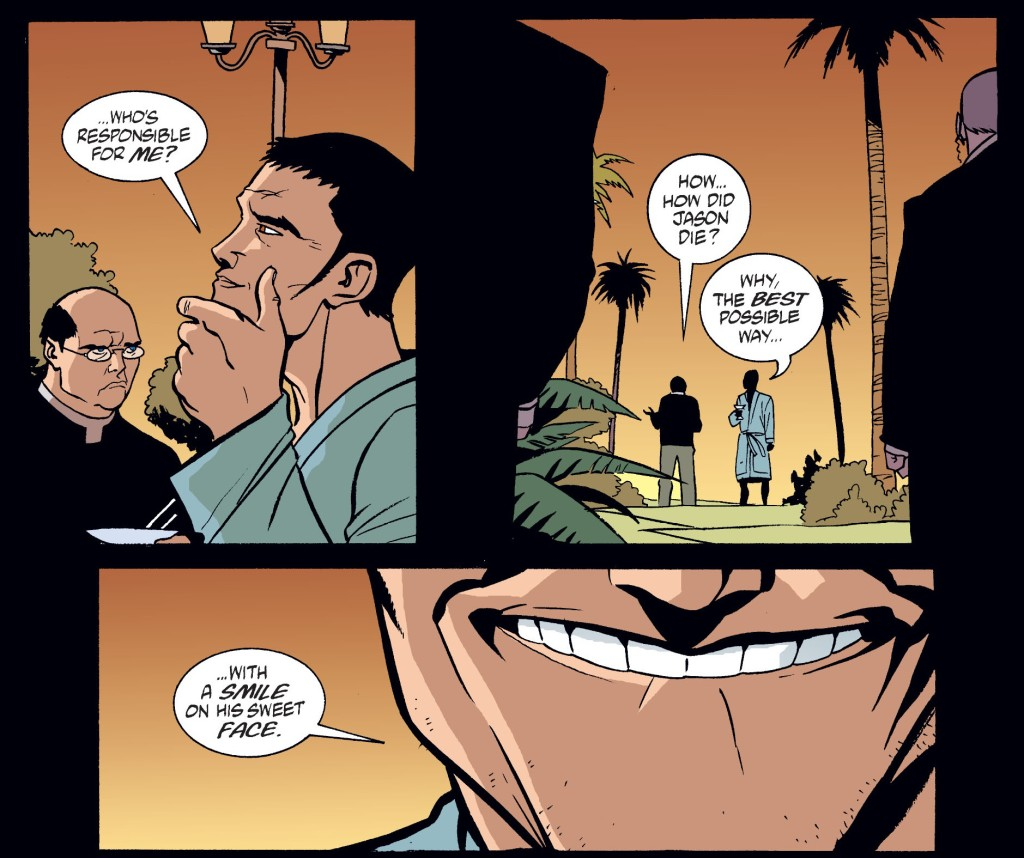 Hellblazer #169
Hellblazer #169
The closing arc of Brian Azzarello’s stint in Vertigo’s long-running horror series Hellblazer was marked by typically off-the-wall creative license. Told in Azzarello’s ultra-cryptic style, it featured high contrast art by Marcelo Frusin (who was also his partner in crime in the revisionist western comic Loveless), as well as by Giuseppe Camuncoli in the prelude. ‘Ashes & Dust in the City of Angels’ caused a bit of a stir by presenting the series’ protagonist, British magician/con man John Constantine, as a bondage-addicted bisexual (in fairness, the S&M element had already been briefly suggested years before by Jamie Delano’s ‘The Horrorist’).
As an additional twist, in the story John Constantine has a destructive relationship with an orphaned billionaire called S.W. Manor (as in Stately Wayne Manor) who lives in a mansion surrounded by bats, with a creepy trophy room, and gets off on misery and guilt. And just to drive the point home, Manor’s butler is called Fredo, his previous ward was called Jason, and his current one is called Tim (the latest Robin being Tim Drake at the time these comics came out). Sure, it’s all part of an extravagant revenge scheme by Constantine, but that doesn’t change the fact that Brian Azzarello came the closest to writing canonical Batman/Constantine slash fiction released by a major publisher!
So why go out and watch 50 Shades of Grey when you can stay home and read a pun-filled comic where Batman plays a dominated love slave?
NEXT: Catwoman kicks ass.




The vibe I’ve always gotten from Azzarello is that he really, really wants to be the Quentin Tarantino of comics. Sometimes this pays off beautifully (I’ll continue to stick up for “Broken City” most days); other times it doesn’t (why hello thar Joker, to say nothing of his Wonder Woman run…).
Incidentally, could you elaborate a little on your thoughts on Superman: For Tomorrow? I only thumbed through it once at my local library – never had the inclination to read further…
For Tomorrow has got to be one of the worst Superman comics I’ve read. I think that it was one of the first times when Azzarello, instead of playing to his strengths as a writer of labyrinthine crime tales (like he did in Broken City and Luthor), actually went for larger-than-life superhero opera, and he didn’t feel very at home… we ended up with a lot of confusing, self-important conversations between a brooding Man of Steel and a priest (who is later turned into an awful cyborg-looking monster for some reason), squeezing the well trodden Superman/God thing. There may be an interesting story hidden in there somewhere – about Superman creating a whole backup world – but the execution is too close to ‘90s Image Comics for my taste.
By the way, after years of waiting, Batman: Europa finally came out, in 2016. It was also pretty disappointing all around.